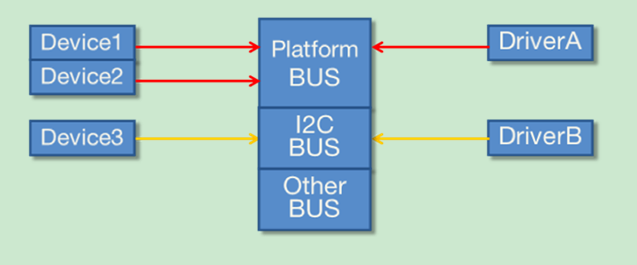Linux Device Model 三角關係
Linux Device Model由bus, device, driver所組成。其關係為: bus是cpu與device溝通的橋樑,而driver賦與device行為的能力。因此有人說,device是男人,driver是女人,而bus則是媒人。媒人有match的功能,讓男人與女人彼此 認識。在coldplug的時代,男人先登記後,由媒人去match女人。而後來的hotplug,則讓女人先提供資訊,讓後來有意願的男人match。 device與driver對bus而言,就沒有一定誰先誰後了。
###基礎
kobject做為LDM的最基本結構,提供了reference count (kref)、sysfs的dirent和hotplug相的的event等其他屬性。bus, device, driver都會是一個kobject,意即其struct都內含一個kobject。
include/linux/kobject.h
struct kobject {
const char *name;
struct list_head entry;
struct kobject *parent;
struct kset *kset;
struct kobj_type *ktype;
struct sysfs_dirent *sd;
struct kref kref;
unsigned int state_initialized:1;
unsigned int state_in_sysfs:1;
unsigned int state_add_uevent_sent:1;
unsigned int state_remove_uevent_sent:1;
unsigned int uevent_suppress:1;
};
kset理解為kobject的集合。可以想像為pci bus是一個kset,而掛在pci bus上的一個個device / driver的kobject為其成員。
###結構
include/linux/device.h
###先看bus
struct bus_type {
const char *name;
struct bus_attribute *bus_attrs;
struct device_attribute *dev_attrs;
struct driver_attribute *drv_attrs;
int (*match)(struct device *dev, struct device_driver *drv);
int (*uevent)(struct device *dev, struct kobj_uevent_env *env);
int (*probe)(struct device *dev);
int (*remove)(struct device *dev);
void (*shutdown)(struct device *dev);
int (*suspend)(struct device *dev, pm_message_t state);
int (*resume)(struct device *dev);
const struct dev_pm_ops *pm;
struct bus_type_private *p; //2.6.19後把device和driver包在新的struct
};
struct bus_type_private {
struct kset subsys; //代表自己,而kset本身也是一種kobject
struct kset *drivers_kset; //該bus的driver集合
struct kset *devices_kset; //該bus的 device集合
struct klist klist_devices;
struct klist klist_drivers;
struct blocking_notifier_head bus_notifier;
unsigned int drivers_autoprobe:1;
struct bus_type *bus;
};
###再來是device
struct device {
struct device *parent;
struct device_private *p;
struct kobject kobj;
const char *init_name; /* initial name of the device */
struct device_type *type;
struct mutex mutex; /* mutex to synchronize calls to its driver.*/
struct bus_type *bus; /* type of bus device is on */ //指定要掛在哪條bus
struct device_driver *driver; /* which driver has allocated this //該device所 bind的driver device */
void *platform_data; /* Platform specific data, device core doesn't touch it */
struct dev_pm_info power;
/*...............*/
};
###最後是driver
struct device_driver {
const char *name;
struct bus_type *bus; //一樣是用來指定要去哪條bus做 match
struct module *owner;
const char *mod_name; /* used for built-in modules */
bool suppress_bind_attrs; /* disables bind/unbind via sysfs */
#if defined(CONFIG_OF)
const struct of_device_id *of_match_table;
#endif
int (*probe) (struct device *dev);
int (*remove) (struct device *dev);
void (*shutdown) (struct device *dev);
int (*suspend) (struct device *dev, pm_message_t state);
int (*resume) (struct device *dev);
const struct attribute_group **groups;
const struct dev_pm_ops *pm;
struct driver_private *p; //kobject在這
};
struct driver_private {
struct kobject kobj;
struct klist klist_devices; //該driver能支援的device列表
struct klist_node knode_bus;
struct module_kobject *mkobj;
struct device_driver *driver;
};
基本上這就是LDM三個主角的結構。拿pci driver當例子
drivers/pci/pci-driver.c
###bus的部分
struct bus_type pci_bus_type = {
.name = "pci",
.match = pci_bus_match,
.uevent = pci_uevent,
.probe = pci_device_probe,
.remove = pci_device_remove,
.shutdown = pci_device_shutdown,
.dev_attrs = pci_dev_attrs,
.bus_attrs = pci_bus_attrs,
.pm = PCI_PM_OPS_PTR,
};
宣告了pci bus及其屬性。
static int __init pci_driver_init(void)
{
return bus_register(&pci_bus_type);
}
postcore_initcall(pci_driver_init);
__init macro表示在開機時會作初始化,即do_basic_setup時,其level是在postcore,細節可參考include/linux /init.h
#define pure_initcall(fn) __define_initcall("0",fn,0)
#define core_initcall(fn) __define_initcall("1",fn,1)
#define core_initcall_sync(fn) __define_initcall("1s",fn,1s)
#define postcore_initcall(fn) __define_initcall("2",fn,2)
#define postcore_initcall_sync(fn) __define_initcall("2s",fn,2s)
#define arch_initcall(fn) __define_initcall("3",fn,3)
#define arch_initcall_sync(fn) __define_initcall("3s",fn,3s)
#define subsys_initcall(fn) __define_initcall("4",fn,4)
#define subsys_initcall_sync(fn) __define_initcall("4s",fn,4s)
#define fs_initcall(fn) __define_initcall("5",fn,5)
#define fs_initcall_sync(fn) __define_initcall("5s",fn,5s)
#define rootfs_initcall(fn) __define_initcall("rootfs",fn,rootfs)
#define device_initcall(fn) __define_initcall("6",fn,6)
#define device_initcall_sync(fn) __define_initcall("6s",fn,6s)
#define late_initcall(fn) __define_initcall("7",fn,7)
#define late_initcall_sync(fn) __define_initcall("7s",fn,7s)
再來就是其module_init,可看到最後是執行了bus_register(&pci_bus_type),節錄如下:
int bus_register(struct bus_type *bus)
{
/*...............*/
retval = kobject_set_name(&priv->subsys.kobj, "%s", bus->name);
/*...............*/
retval = kset_register(&priv->subsys);
if (retval)
goto out;
retval = bus_create_file(bus, &bus_attr_uevent);
if (retval)
goto bus_uevent_fail;
priv->devices_kset = kset_create_and_add("devices", NULL,
&priv->subsys.kobj);
if (!priv->devices_kset) {retval = add_probe_files(bus);
retval = -ENOMEM;
goto bus_devices_fail;
}
priv->drivers_kset = kset_create_and_add("drivers", NULL,
&priv->subsys.kobj);
/*...............*/
retval = add_probe_files(bus);
/*...............*/
}
這其中包括建立sysfs下的file,可看出devices及drivers兩個資料夾。而後的add_probe_files則是sysfs下更detail的部份。
這樣的結果就是在/sys/bus/下會多出一個pci的folder。之後就是kernel scan到devices/ drivers時,再加入/sys/bus/pci/devices/及/sys/bus/pci/drivers/。
###再來是device
drivers/pci/pci.h
這其實是再封裝了include/linux/device.h裡的struct device,加上了自定的其他屬性
struct pci_dev {
struct list_head bus_list; /* node in per-bus list */
struct pci_bus *bus; /* bus this device is on */
struct pci_bus *subordinate; /* bus this device bridges to */
void *sysdata; /* hook for sys-specific extension */
struct proc_dir_entry *procent; /* device entry in /proc/bus/pci */
struct pci_slot *slot; /* Physical slot this device is in */
unsigned int devfn; /* encoded device & function index */ //該device的id資訊,將來跟driver用來 match
unsigned short vendor;
unsigned short device;
unsigned short subsystem_vendor;
unsigned short subsystem_device;
unsigned int class; /* 3 bytes: (base,sub,prog-if) */
u8 revision; /* PCI revision, low byte of class word */
u8 hdr_type; /* PCI header type (`multi' flag masked out) */
u8 pcie_cap; /* PCI-E capability offset */
u8 pcie_type; /* PCI-E device/port type */
u8 rom_base_reg; /* which config register controls the ROM */
u8 pin; /* which interrupt pin this device uses */
struct pci_driver *driver; /* which driver has allocated this device */ //match到則用device_bind_driver(dev),即不為NULL
/*...............*/
struct device dev; /* Generic device interface */
int cfg_size; /* Size of configuration space */
/*
* Instead of touching interrupt line and base address registers
* directly, use the values stored here. They might be different!
*/
unsigned int irq;
struct resource resource[DEVICE_COUNT_RESOURCE]; /* I/O and memory regions + expansion ROMs */
resource_size_t fw_addr[DEVICE_COUNT_RESOURCE]; /* FW-assigned addr */
//其他自定屬性
/* These fields are used by common fixups */
unsigned int transparent:1; /* Transparent PCI bridge */
unsigned int multifunction:1;/* Part of multi-function device */
/* keep track of device state */const struct pci_device_id *id_table; /* must be non-NULL for probe to be called */
unsigned int is_added:1;
unsigned int is_busmaster:1; /* device is busmaster */
unsigned int no_msi:1; /* device may not use msi */
unsigned int block_ucfg_access:1; /* userspace config space access is blocked */
/*...............*/
};
###最後是pci_driver
跟pci_dev一樣,再次封裝struct device_driver
struct pci_driver {
struct list_head node;
char *name;
const struct pci_device_id *id_table; /* must be non-NULL for probe to be called */ //內含其支援的device id資訊,將來match時用的
int (*probe) (struct pci_dev *dev, const struct pci_device_id *id); /* New device inserted */
void (*remove) (struct pci_dev *dev); /* Device removed (NULL if not a hot-plug capable driver) */
int (*suspend) (struct pci_dev *dev, pm_message_t state); /* Device suspended */
int (*suspend_late) (struct pci_dev *dev, pm_message_t state);
int (*resume_early) (struct pci_dev *dev);
int (*resume) (struct pci_dev *dev); /* Device woken up */
void (*shutdown) (struct pci_dev *dev);
struct pci_error_handlers *err_handler;
struct device_driver driver;
struct pci_dynids dynids;
};
以上是LDM的結構,再來要看看範例以及device/driver的註冊過程。
Reference
高茂林
